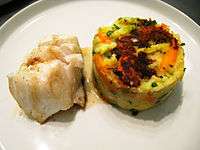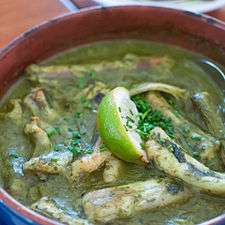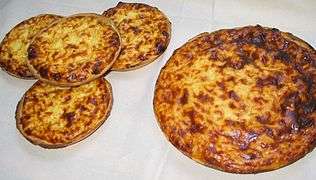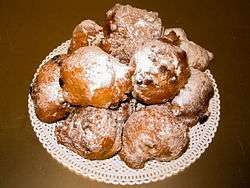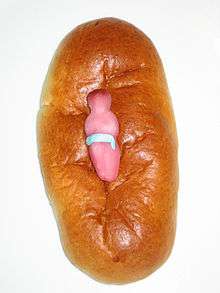Belgian cuisine


| Part of a series on the |
| Culture of Belgium |
|---|
 |
| History |
| People |
| Languages |
| Cuisine |
| Festivals |
| Religion |
| Art |
| Literature |
|
Music and performing arts |
| Sport |
|
Monuments |
|
Symbols |
|
Belgian cuisine is widely varied with significant regional variations while also reflecting the cuisines of neighbouring France, Germany and the Netherlands. It is sometimes said that Belgian food is served in the quantity of German cuisine but with the quality of French food.[1][2] Outside the country, Belgium is best known for its chocolate, waffles, fries and beer.
Though Belgium has many distinctive national dishes, many internationally popular foods like hamburgers and spaghetti bolognese are also popular in Belgium, and most of what Belgians eat is also eaten in neighbouring countries. 'Belgian cuisine' therefore usually refers to dishes of Belgian origin, or those considered typically Belgian.
Belgian cuisine traditionally prizes regional and seasonal ingredients. Ingredients typical in Belgian dishes include potatoes, leeks, grey shrimp, white asparagus, Belgian endives and local beer, in addition to common European staples including meat, cheese and butter. Belgians typically eat three meals a day, with a light breakfast, medium or large-sized lunch and small dinner.
Belgium has a plethora of dishes and products that are local to a specific area. Examples include waterzooi from Ghent, the couque biscuit from the town of Dinant, and tarte au riz from Verviers. While their local origins are acknowledged, most such dishes are enjoyed throughout Belgium.
Typical dishes
Appetizers
- Boterhammen / Tartines: Slices of rustic bread and an uncovered spread, often pâté or soft cheese, served on a cutting board. A typical variety is a slice of bread with sliced radishes, typically accompanied by a glass of gueuze.
- Charcuterie: particularly smoked ham (Jambon d'Ardennes) and pâté, often made of game such as wild boar. The forested Ardennes region in the south of Belgium is renowned for this type of food.
- Salade Liégeoise: a salad with green beans, bacon, onions and vinegar. It is usually associated with Liège.
- Tomate-crevette / Tomaat-garnaal: a snack or starter of grey shrimp (which is particularly popular in Belgium) and mayonnaise stuffed into a hollowed-out raw tomato.
Savoury dishes

- Moules-frites / Mosselen-friet: mussels cooked or steamed with onions and celery served with fries. The recipe has often been referred to as the country's national dish[3] but is also popular in the neighboring Nord region of France.
- Carbonade flamande / Stoverij: a Belgian beef stew, similar to the French Beef Bourguignon, but made with beer instead of red wine. Served with bread or fries and mustard. Usually accompanied by a beer. This is also considered one of the national dishes, along with moules-frites.
- Steak-frites
- Waterzooi: a rich stew and soup of chicken or fish, vegetables, cream and eggs, usually associated with the town of Ghent.
- Gegratineerde witloof / Chicons au gratin: a gratin of Belgian endives in béchamel sauce with cheese. Often the endives are wrapped with ham.
- Kip met frieten en appelmoes / Poulet-frites-compote (chicken, fries and apple sauce).
- Konijn in geuze / Lapin à la gueuze: rabbit in gueuze, which is a spontaneously fermented beer from the area around Brussels.
- Filet américain: Very finely minced ground beef eaten raw and cold. It is spread on a sandwich or bread with and sometimes topped with a sauce, usually with Sauce américaine, and served with fries. When served as a dinner, it is mixed with onions and capers like steak tartare, but it retains the name américain.
- Paling in 't groen / Anguilles au vert: Eel in a green sauce of mixed herbs (including chervil and parsley). Served with bread or fries. Usually accompanied by a beer or (sometimes) an Alsace wine.
- Pêches au thon / Perziken met tonijn: halved canned or fresh peaches stuffed with a mix of tuna and mayonnaise, i.e. tuna salad.
- Boudin / Pensen, beuling or bloedworst: a type of sausage in which the meat, or blood, is mixed with fine breadcrumbs. Often eaten with potatoes and apple sauce, sometimes eaten raw or barbecued.
- Stoemp: potato mashed with vegetables (usually carrots or cabbage), often served with sausages.
Sweet dishes and desserts

- Waffles: sometimes eaten as a street snack and sold by ice-cream vans. Among the better-known styles are the Liège waffle, Brussels waffle and the stroopwafel
- Speculoos: a shortcrust cinnamon biscuit.
- Smoutebollen / Croustillons: Deep-fried balls of sweet dough, eaten at fairgrounds or on special occasions
- Tarte au riz / Rijstevlaai: a pie with a filling based on rice pudding, native to Verviers.
- Sirop de Liège / Luikse siroop: a jam or jelly-like spread made of evaporated fruit juices
Fries and fries in culture


Fries, deep-fried chipped potatoes, are very popular in Belgium, where they are thought to have originated. The earliest evidence of the dish comes from a book entitled Curiosités de la table dans les Pays-Bas-Belgiques written in 1781, which described how inhabitants of Namur, Dinant and Andenne around the Meuse River had eaten fried potatoes since around 1680.[3] Though they are usually known as "French fries" in the United States, it is argued that American soldiers during the First World War erroneously believed that they were being served the dish in France.[4]
In Belgium, fries are sold at fast food stands or in dedicated fast-food restaurants called friteries, frietkot, or frituur (loosely: fry shack). They are often served with a variety of sauces and eaten either on their own or in the company of other snacks. Traditionally, they are served in a "cornet de frites" (French) or "puntzak" (Dutch), a cone-shaped white piece of cardboard then wrapped in a piece of paper, with the sauce on the top. Larger portions are often served in cardboard trays for practicality's sake. Other street foods like frikandel, gehaktbal or croquette are sold alongside. In some cases, the fries are served in the form of a baguette sandwich along with their sauce and meat; this is known as a "mitraillette".[5] In areas with immigration, the same combination is also available in a wrap called a dürüm instead of on a baguette.
The vast majority of Belgian households have a deep fryer, allowing them to make their own fries and other deep-fried foods at home. Supermarkets sell a range of liquid and solid animal- and plant-based fats for use in home deep fryers; beef fat is particularly prized.
Sauces
Mayonnaise[6] and ketchup are the sauces traditionally eaten with fries in Belgium. Friteries and other fast-food establishments tend to offer a number of different sauces for the fries and meats, including aioli and sauce Americaine but also much more elaborate varieties, including Béarnaise sauce.[7] There are frequently over a dozen options, and most are mayonnaise-based.[8] Varieties include:
- Aioli / Looksaus (garlic mayonnaise).
- Sauce andalouse – mayonnaise with tomato paste and peppers.
- Sauce Americaine – mayonnaise with tomato, chervil, onions, capers, crustacean stock and celery.
- "Bicky" sauce – a commercial brand made from mayonnaise, white cabbage, tarragon, cucumber, onion, mustard and dextrose.
- Brasil sauce – mayonnaise with pureed pineapple, tomato and spices[9]
- Cocktail sauce (mayonnaise–based)
- Curry ketchup
- Curry mayonnaise
- Joppiesaus – a commercial brand made from mayonnaise, spices, onion and curry powder
- Ketchup
- Mammoet–sauce – mayonnaise, tomato, onion, glucose, garlic, soy sauce
- Mayonnaise
- Pepper–sauce – mayonnaise with black pepper.
- Sauce "Pickles"– a yellow vinegar based sauce with turmeric, mustard and crunchy vegetable chunks, similar to Piccalilli.
- Sauce Riche – a pink, tartar–based sauce
- Pita sauce
- Samurai–sauce – mayonnaise with Tunisian chili, spices, tomatoes, and bell peppers
- Tartar sauce
- Zigeuner sauce – A "gypsy" sauce of tomatoes, paprika and chopped bell peppers, borrowed from Germany
Occasionally warm sauces are offered by friteries, including Hollandaise sauce, sauce Provençale, Béarnaise sauce, or even a carbonade flamande.
Most of the sauces above are also readily available in supermarkets. The use of these sauces is not limited to fries; they are used on a variety of other dishes as well.
Beer
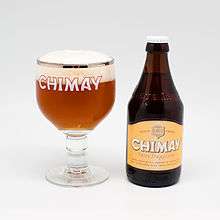
For a comparatively small country, Belgium produces a very large number of beers in a range of different styles – in fact, it has more distinct types of beer per capita than anywhere else in the world. In 2011, there were 1,132 different varieties of beer being produced in the country.[10] The brewing tradition in Belgium can be traced back to the early Middle Ages and 6 Trappist Monasteries still produce beer, which was initially used to fund their upkeep.[11]
On average, Belgians drink 84 litres of beer each year, down from around 200 each year in 1900.[11] Most beers are bought or served in bottles, rather than cans, and almost every style of beer has its own particular, uniquely shaped glass or other drinking-vessel.[2] Using the correct glass is considered to improve its flavour.
The varied nature of Belgian beers makes it possible to match them against each course of a meal, for instance:
- Wheat beer with seafood or fish.
- Blonde or Tripel beers with eel, chicken or white meat
- Dubbel or other dark beers with dark meat
- Fruit Lambics with dessert
A number of traditional Belgian dishes use beer as an ingredient. One is carbonade, a stew of beef cooked in beer, similar to boeuf bourguignon. The beer used is typically the regional speciality: lambic in Brussels, De Koninck in Antwerp, so that the taste of the dish varies. Another is rabbit in gueuze. The Trappist monastery at Chimay also manufactures cheese that is "washed" with beer to enhance its flavour.[12]
Jenever
Jenever, also known as genièvre, genever, peket or Dutch gin, is the national spirit of Belgium from which gin evolved. While beer may be Belgium's most famous alcoholic beverage, jenever has been the country's traditional and national spirit for over 500 years.[13] Jenever is a "Protected Product of Origin", having received eleven different appellations or AOCs from the European Union, and can only be crafted in Belgium, the Netherlands and a few areas in France and Germany. Most of the jenever AOC's are exclusive to Belgium making Belgian jenever (Belgian genever) one of the best-kept secrets in the liquor industry.
For centuries jenever has been bottled in jugs handcrafted from clay. Its iconic shape is recognizable and unique to jenever.[14] Traditionally the Belgians serve jenever in completely full shot glasses that have just been pulled from the freezer. The first step to drinking the jenever properly is to keep the glass on the table, bend down and take the first sip without holding the glass. Once this traditional first sip is completed one can drink the rest of the drink normally.
Chocolate

Belgium is famed for its high quality chocolate and over 2,000[15] chocolatiers, both small and large. Belgium's association with chocolate goes back as far as 1635[15] when the country was under Spanish occupation. By the mid 18th century, chocolate was extremely popular in upper and middle class circles, particularly in the form of hot chocolate, including with Charles-Alexander of Lorraine, the Austrian governor of the territory.[16] From the early 20th century, the country was able to import large quantities of cocoa from its African colony, the Belgian Congo. Both the chocolate bar and praline are inventions of the Belgian chocolate industry.[17] Today, chocolate is very popular in Belgium, with 172,000 tonnes produced each year, and widely exported.[15]
The composition of Belgian chocolate has been regulated by law since 1884. In order to prevent adulteration of the chocolate with low-quality fats from other sources, a minimum level of 35% pure cocoa was imposed.[18] Adherence to traditional manufacturing techniques also serves to increase the quality of Belgian chocolate. In particular, vegetable-based fats are not used.[19] Many firms produce chocolates by hand, which is laborious and explains the prevalence of small, independent chocolate outlets, which are popular with tourists. Famous chocolate companies, like Neuhaus and Guylian, strictly follow traditional (and sometimes secret) recipes for their products.
Seafood pralines (pralines shaped like sea shells or fish) are popular with tourists and are sold all over Belgium.
Gallery
Appetizers and light fare
-

A bowl of grey shrimp as a snack
-

Jambon d'Ardenne ham hanging from a rack
-

Dried Ardenne sausage
-

The Trappist Chimay Brewery's Grand Cru cheese
-

Belgian endives in a market
-
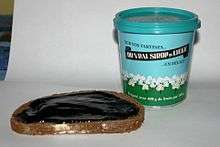
Sirop de Liège on a slice of bread
-

An assortment of sauces
-
Pêches au thon / Perziken met tonijn
Main dishes
-
_2.jpg)
Chicken waterzooi
-

Carbonade flamande / Stoverij with fries and salad
-

Oiseau sans tête / blinde vink
Sweet dishes and desserts
-

Cuberdon candies
-

Pain d'épices / ontbijtkoek spiced bread
-

Speculoos cookies
-

Fresh Liège waffles
-

Galettes campinoises / Kempense galetten
-
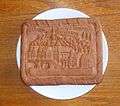
A couque de Dinant biscuit
See also
References
- ↑ "Belgian cuisine - General". www.belgium.alloexpat.com. Retrieved 14 February 2013.
- 1 2 Michael Jackson's Great Beers of Belgium, Michael Jackson, ISBN 0-7624-0403-5
- 1 2 Malgieri, Nick. "A National Obsession: Belgium's Moules Frites". saveur.com. Retrieved 13 November 2012.
- ↑ "La Frite est-elle belge?". frites.be. Archived from the original on 24 May 2013. Retrieved 3 March 2012.
- ↑ Malhotra, Saira. "La Mitraillette (Belgian Machine Gun) Sandwich Recipe". Marcus Samuelsson. Retrieved 11 March 2013.
- ↑ Erdos, Joseph. "Pommes frites with Mayonnaise". www.gastronomersguide.com. Retrieved 14 February 2013.
- ↑ "La Frite se mange-t-elle à toutes les sauces?". www.frites.be. 2011. Archived from the original on November 16, 2008. Retrieved April 20, 2011.
- ↑ Seth Kugel (June 11, 2013). "In Brussels, Frites Are More Than Just Fries". New York Times. Retrieved June 13, 2013.
- ↑ D&L Archived August 19, 2014, at the Wayback Machine., La William
- ↑ "500 nieuwe bieren in 4 jaar". De Standaard. 18 October 2011. Retrieved 10 March 2013.
- 1 2 "Brewed force". The Economist. 17 December 2011. Retrieved 10 March 2013.
- ↑ "Le Chimay à la Bière : fruity and intense". Chimay. Retrieved 10 March 2013.
- ↑ "Belgian Genever". Flemish Lion. Retrieved 18 April 2014.
- ↑ Jenever book "Genever: 500 Years of History in a Bottle"
- 1 2 3 Savage, Maddy (31 December 2012). "Is Belgium still the capital of chocolate?". BBC. Retrieved 14 February 2013.
- ↑ Mercier, Jacques (2008). The Temptation of Chocolate. Brussels: Lannoo. p. 87. ISBN 2873865334.
- ↑ Mercier, Jacques (2008). The Temptation of Chocolate. Brussels: Lannoo. p. 101. ISBN 2873865334.
- ↑ Mercier, Jacques (2008). The Temptation of Chocolate. Brussels: Lannoo. p. 94. ISBN 2873865334.
- ↑ Hardy, Christophe. "A brief history of Belgian Chocolate". Puratos. Retrieved 14 February 2013.
Further reading
- Analysis and context
- Scholliers, Peter; Geyzen, Anneke (Spring 2010). "Upgrading the Local: Belgian Cuisine in Global Waves". Gastronomica: The Journal of Critical Food Studies. 10 (2): 49–54.
- Recipes
- Elkon, Juliette (1996). A Belgian Cookbook. New York: Hippocrene Books. ISBN 0-7818-0461-2.
- Gordon, Enid; Shirley, Midge (1983). The Belgian Cookbook. London: Macdonald. ISBN 0-356-09501-0.
- Blais, Denis; Plisnier, Andre (1998). Belgo Cookbook. London: Phoenix Illustrated. ISBN 0-75380-490-5.
External links
- Traditional Belgian cuisine and beer pairing (English) from BeerTourism.com
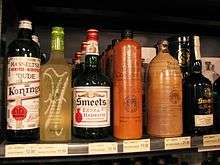
.jpg)

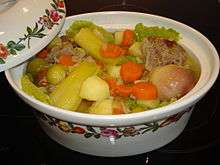
.jpg)
